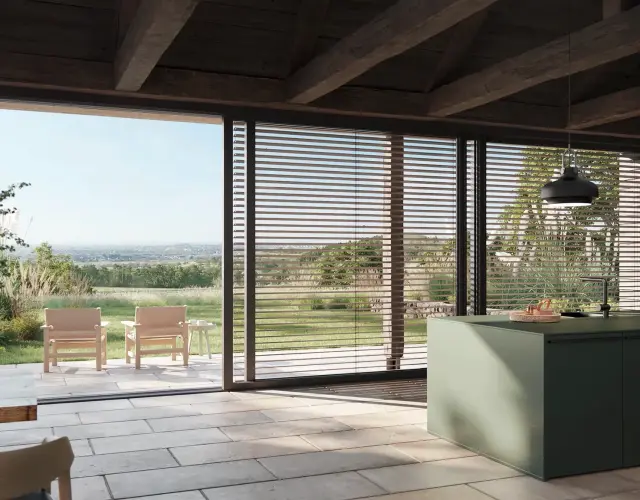
EPD Resources for Architects and Planners
- Back
- Home
- Services & Tools
- Downloads
As a leading manufacturer of sun shading systems, taking responsibility for our actions has always come naturally to us. For this reason, we have set ourselves specific targets for reducing the environmental impacts of our products throughout their entire life cycle and providing transparent information about these impacts.
As well as measuring our product carbon footprints (PCFs), we have also drawn up environmental product declarations (EPDs) in collaboration with the German Association of the Roller Shutter, Sun Shading and Automation Industry (IVRSA e.V.) and the German Institute for Construction and the Environment (IBU e.V.) to provide detailed information about the environmental impacts of our external venetian blinds, roller shutters and window awnings.
Integrated planning
The standardised EPDs provide traceable information about the environmental characteristics of our sun shading systems throughout their entire life cycle, including their energy consumption and the resulting global warming potential, for example. As a result, it is possible to choose the most environmentally friendly products as part of an integrated planning process. The EPDs also form the basis for building certification in accordance with sustainability systems such as DGNB, LEED and BREEAM.
Download EPDs
Climate protection systems
In the context of climate change, external sun shading systems play an essential role in keeping the temperature inside buildings comfortable. They prevent sunshine from entering the building directly and reduce the incidence of energy. Automated solutions in particular help to reduce cooling loads, energy consumption and ultimately CO 2 emissions.
A calculation of the CO 2 footprint of the three most popular sun shading solutions from WAREMA clearly indicates that, during their service life, external sun shading systems can save up to 28 times more CO 2 than is produced during the entire product value chain. *
*The calculations were based on a standard medium-sized product variant of the external venetian blind window system, the front-mounted roller shutter and the front-mounted awning.
The basis for the calculation of the CO 2 emissions is the internationally recognised Greenhouse Gas Protocol. All three scopes were analysed, in other words, direct and indirect emissions at the production site and indirect emissions along the value chain.
The potential CO 2 savings were calculated on the basis of a room in a non-residential building (LxWxH 8.25 m x 5.4 m x 2.8 m) with 70 percent window space (16.17m 2 ) on the western side. Active cooling was defined at 22°C. The service life of the sun shading product was assumed to be 20 years, or 10,000 load changes. The calculations were performed using a tool provided by Repräsentanz Transparente Gebäudehülle (RTG).
The results showed that the carbon dioxide emissions of the sun shading products are between 265 and 293 kg of CO 2 equivalents (CO 2e ). By contrast, the potential savings during a product’s service life are up to 28 times higher than its CO 2 emissions. Under the conditions of use described above, a window awning can save up to 7297 kg CO 2e , an external venetian blind up to 5834 kg CO 2e and a roller shutter up to 3931 kg CO 2e . Even in the case of a roller shutter, the potential CO 2 savings are 13 times higher than the CO 2 emitted during the product’s entire life cycle.
Your direct contact to us

Hotline for architects





